What Metrics Matter Most for Call Centers in 2025
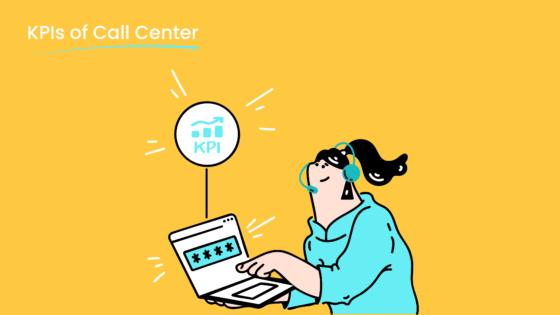
Tracking call center key performance indicators has become essential for businesses aiming to stay competitive in 2025. Customers now demand faster and more personalized service. Nearly 85% expect immediate access to support teams, while 75% prioritize first-contact resolution for a positive experience. These expectations make effective call center KPI tracking critical for success. Advanced tools like AI and real-time analytics allow you to monitor metrics instantly, enabling quicker decision-making and improved outcomes. Sobot’s solutions, for instance, integrate these technologies to help you enhance operational efficiency and deliver exceptional customer experiences.
Understanding Call Center Key Performance Indicators
What Are Call Center KPIs?
Call center KPIs are measurable values that help you evaluate the performance of your call center. These metrics provide insights into how well your team meets customer expectations and achieves business goals. For example, tracking metrics like Customer Satisfaction Score (CSAT) or First Contact Resolution (FCR) allows you to assess the quality of service your agents deliver. By focusing on these critical KPIs, you can identify areas for improvement and implement strategies to enhance overall efficiency.

In 2025, advanced tools like Sobot’s Voice/Call Center make it easier to monitor these KPIs in real time. Features such as intelligent IVR and AI-powered voicebots streamline operations, ensuring you can track and optimize performance seamlessly. This approach not only improves customer interactions but also empowers your agents to perform at their best.
Why Are Call Center Metrics Crucial for Success?
Call center metrics are essential because they directly impact customer satisfaction and operational efficiency. When you monitor these metrics, you gain a clear understanding of your team's strengths and weaknesses. For instance, tracking Average Handle Time (AHT) helps you identify bottlenecks in your processes, while monitoring Net Promoter Score (NPS) reveals how likely customers are to recommend your services.
Metrics also play a vital role in decision-making. With tools like Sobot’s real-time analytics, you can make data-driven adjustments to improve service levels. This ensures your call center remains agile and responsive to customer needs, giving you a competitive edge in a fast-paced market.
The Impact of KPIs on Customer Experience and Business Growth
KPIs are more than just numbers; they are the foundation of a successful call center strategy. By focusing on the right metrics, you can transform customer experiences and drive business growth.
- A retail chain improved its CSAT scores by 15% and increased its NPS from 25 to 45 by analyzing survey data and implementing targeted staff training. This led to higher customer loyalty and better sales performance.
- A tech startup reduced its time to insights by 40% through advanced data analytics. Continuous KPI monitoring validated their strategies, resulting in sustainable growth.
These examples highlight how tracking KPIs can lead to tangible benefits. With Sobot’s unified workspace and AI-driven tools, you can replicate these successes. By integrating data from multiple channels, Sobot enables you to deliver personalized service, reduce customer effort, and achieve measurable improvements in key metrics.
Top Customer Experience Metrics for Call Centers in 2025
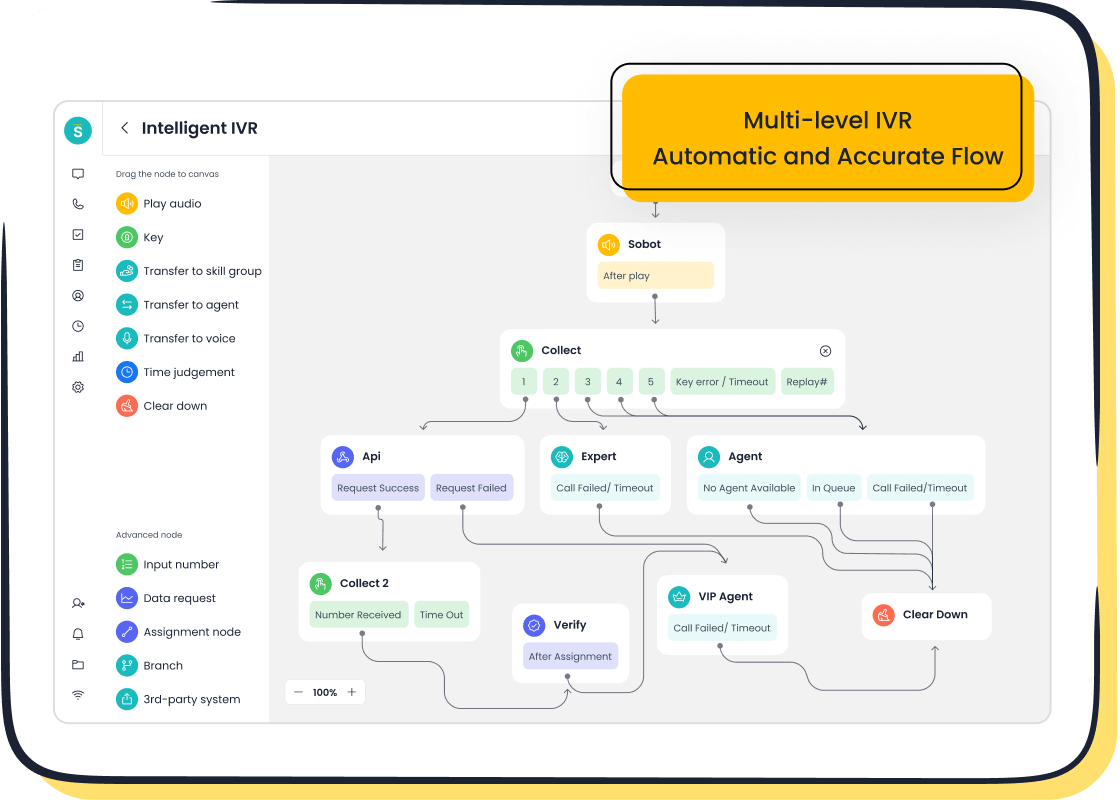
Customer Satisfaction Score (CSAT)
Customer Satisfaction Score (CSAT) measures how happy customers are with the service they receive. It’s one of the most important call center metrics because it directly reflects the quality of your customer interactions. You calculate CSAT by asking customers to rate their satisfaction after a call, typically on a scale of 1 to 5. Higher scores indicate better service.
Benchmarking CSAT scores helps you understand where your call center stands. For example, industry averages range from 75% to 85%, while top-performing sectors like software and e-commerce achieve scores as high as 89%.
| Source | CSAT Score Range | Industry Focus |
|---|---|---|
| CSAT Benchmarks by Industry | 75 to 85 | General benchmarks |
| Customer Service Quality Benchmark Report | Average 89% | Software, e-commerce |

Sobot’s Voice/Call Center enhances CSAT by integrating AI-powered voicebots and intelligent IVR systems. These tools reduce average handling time and improve first-contact resolution, ensuring customers leave satisfied. By leveraging real-time analytics, you can identify trends in customer feedback and make adjustments to improve satisfaction levels.
First Contact Resolution (FCR)
First Contact Resolution (FCR) measures how often customer issues are resolved during the first interaction. It’s a critical KPI because it impacts both customer satisfaction and operational efficiency. Customers value quick answers, and resolving their concerns on the first call reduces frustration and builds loyalty.
The average FCR rate across the call center industry is just under 70%, but world-class centers achieve rates above 80%. Studies show that improving FCR can significantly boost caller satisfaction. For example:
- A good FCR rate ranges between 70% and 79%.
- World-class FCR rates exceed 80%, achieved by only 5% of call centers.
- SQM Group’s 2023 research indicates an aggregated average FCR benchmark of 68%.
Sobot’s AI-powered voicebots and smart call routing systems optimize FCR by directing calls to the right agents and providing instant access to customer data. These features reduce average resolution time and ensure your team can resolve issues efficiently.
Net Promoter Score (NPS)
Net Promoter Score (NPS) gauges customer loyalty by asking a simple question: “How likely are you to recommend our service to others?” Customers respond on a scale from 0 to 10, and their answers categorize them as Promoters, Passives, or Detractors. NPS is a vital metric because it reflects overall customer sentiment and predicts future business growth.
Fortune 500 companies widely adopt NPS due to its simplicity and effectiveness. Higher scores indicate stronger loyalty, which translates into repeat business and positive word-of-mouth. For example:
| Evidence Type | Description |
|---|---|
| Adoption Rate | NPS is widely used by Fortune 500 companies. |
| Customer Loyalty | Strong correlation with loyalty and business growth. |
| Simplicity | Easy to implement and understand. |
Sobot’s unified workspace consolidates customer data, enabling agents to deliver personalized service that boosts NPS. By integrating data from multiple channels, Sobot ensures customers receive consistent and high-quality experiences, turning them into loyal Promoters.
Customer Effort Score (CES)
Customer Effort Score (CES) measures how easy it is for customers to resolve their issues or complete a task when interacting with your call center. This metric focuses on reducing the effort customers need to exert, which directly impacts their loyalty and satisfaction. CES is calculated by asking customers to rate their experience on a scale, typically ranging from "very easy" to "very difficult."
Reducing customer effort has proven to be a powerful driver of retention and loyalty. Studies, including research by the Harvard Business Review, show that customers who experience less effort are more likely to stay loyal and increase their lifetime value. For example:
- Lower effort leads to higher retention rates.
- Simplified processes improve customer satisfaction.
- Businesses that prioritize CES often outperform competitors in customer loyalty metrics.
Sobot’s Voice/Call Center helps you optimize CES by integrating AI-powered voicebots and intelligent IVR systems. These tools streamline interactions, reduce average resolution time, and ensure customers receive quick answers without unnecessary steps. By leveraging real-time analytics, you can identify areas where customers face challenges and implement solutions to make their journey smoother.
Average Handle Time (AHT)
Average Handle Time (AHT) is a critical call center KPI that measures the efficiency of your support team. It calculates the total time agents spend on a call, including talk time, hold time, and after-call tasks. Monitoring AHT helps you identify bottlenecks, optimize resource allocation, and improve customer satisfaction.
Industry benchmarks for AHT vary based on call type and business sector. For customer service calls, the average ranges between 7 and 10 minutes. However, AHT has been increasing due to the handling of simpler queries through self-service options and higher agent turnover. Tracking AHT at the agent level allows you to coach your team effectively and improve customer experience metrics.
Sobot’s Voice/Call Center enhances AHT management with features like smart call routing and unified workspaces. These tools provide agents with instant access to customer data, reducing average wait time and enabling faster resolutions. By analyzing call center metrics in real time, you can pinpoint inefficiencies and implement strategies to lower AHT while maintaining high-quality service.
Key Agent Performance Metrics to Monitor
Agent Utilization Rate
Agent Utilization Rate measures how effectively your agents spend their time handling customer interactions. This metric evaluates the percentage of time agents are actively engaged in calls or related tasks compared to their total available time. A higher utilization rate indicates better workforce efficiency and optimized resource allocation.
| Benefit | Description |
|---|---|
| Efficiency Indicator | Helps managers identify how efficiently agents are using their time. |
| Resource Allocation | Aids in determining appropriate staffing levels and workload distribution. |
| Cost Management | Higher utilization rates can lead to reduced operational costs. |
| Performance Benchmarking | Allows for comparison of agent performance across teams or industry standards. |
Tracking this metric helps you identify underutilized resources and adjust staffing levels to meet demand. For example, a call center with a low utilization rate may experience higher operational costs due to idle time. On the other hand, overworked agents may face burnout, leading to higher turnover rates. Striking the right balance ensures your team remains productive and satisfied.
Sobot’s Voice/Call Center simplifies monitoring this critical KPI with real-time analytics and a unified workspace. These tools provide insights into agent activity, helping you optimize schedules and improve overall performance.
First Response Time (FRT)
First Response Time (FRT) measures the time it takes for your agents to respond to a customer inquiry. This metric is crucial for assessing responsiveness and ensuring a positive customer experience. A lower FRT indicates that your team handles inquiries efficiently, which can enhance satisfaction and increase first contact resolution rates.
- Average First Response Time (AFRT) is a key indicator of service quality.
- A low FRT improves customer satisfaction and reduces the need for follow-up contacts.
- High FRT often leads to frustration and escalations, negatively impacting customer loyalty.
For instance, a call center with an average FRT of under 30 seconds often outperforms competitors in customer satisfaction. Sobot’s smart call routing and AI-powered voicebots ensure customers receive immediate attention, reducing FRT and improving overall service quality. By leveraging these tools, you can address customer concerns promptly and maintain high satisfaction levels.
Call Abandonment Rate
Call Abandonment Rate measures the percentage of customers who hang up before speaking to an agent. This metric reflects the efficiency of your call center operations and directly impacts customer satisfaction. High abandonment rates often indicate long wait times or inadequate staffing, which can frustrate customers and harm your reputation.
| Strategy | Company Type | Abandonment Rate Reduction | Additional Impact |
|---|---|---|---|
| Optimized Staffing Solutions | Telecommunications | 30% | N/A |
| Advanced Routing Systems | Online Retailer | 25% | Improved first-call resolution by 18% |
| Enhanced Agent Training | Financial Services | 20% | Increased customer satisfaction by 15% |
| Implementation of Callback Options | Healthcare Provider | 40% | Increased patient satisfaction |
| Real-Time Analytics | Utility Company | 35% | N/A |
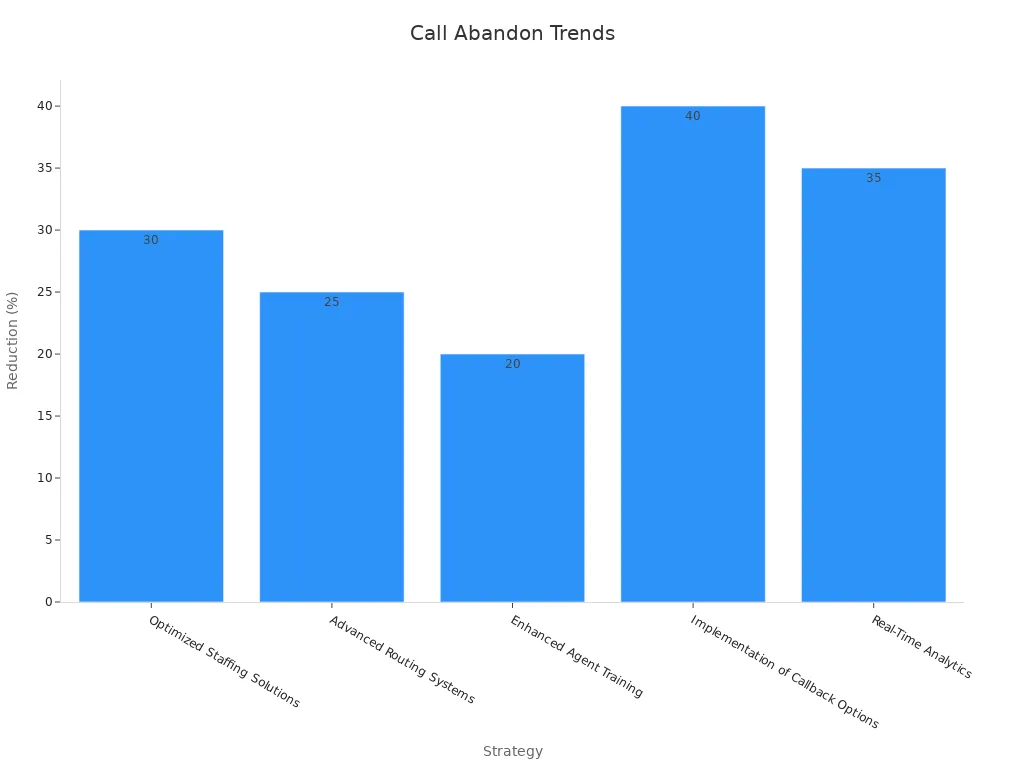
Reducing call abandonment rates requires a combination of strategies, including optimized staffing, advanced routing systems, and callback options. For example, a healthcare provider reduced its abandonment rate by 40% by implementing callback features, which also improved patient satisfaction. Sobot’s Voice/Call Center offers real-time analytics and smart call routing to minimize wait times and ensure customers stay engaged. These features help you maintain low abandonment rates and deliver a seamless customer experience.
Quality Assurance (QA) Scores
Quality Assurance (QA) Scores measure the overall quality of interactions between agents and customers. These scores evaluate how well agents adhere to company standards, resolve issues, and maintain professionalism during calls. QA scores are essential for ensuring consistent service delivery and identifying areas for improvement.
High QA scores often correlate with better customer satisfaction and operational efficiency. For example, a call center with robust QA practices can achieve higher first contact resolution rates and lower call abandonment rates. Metrics like first call resolution, average handling time, and customer satisfaction score contribute to QA evaluations. The table below highlights key metrics used in QA scoring:
| Metric | Description |
|---|---|
| First Call Resolution (FCR) | Measures the percentage of calls resolved on the first interaction. |
| Average Handling Time (AHT) | Average duration taken to handle a call, including talk and hold time. |
| Customer Satisfaction Score (CSAT) | Reflects customer satisfaction with the service received. |
| Net Promoter Score (NPS) | Gauges customer loyalty and likelihood to recommend the service. |
| QA Score | Overall quality score based on various performance metrics. |
Sobot’s Voice/Call Center enhances QA monitoring with real-time analytics and intelligent tools. Features like call tracking and AI-powered voicebots allow you to analyze interactions and identify areas where agents can improve. By leveraging these insights, you can enhance service quality and maintain high QA scores across your team.
Agent Turnover Rate
Agent turnover rate measures the percentage of agents who leave your call center within a specific period. High turnover rates can disrupt operations, increase recruitment costs, and negatively impact customer satisfaction. Understanding the factors influencing turnover helps you create strategies to retain skilled agents.
Different types of call centers experience varying turnover rates. For example, inbound customer support centers typically see rates between 20% and 30%, while outbound sales centers face higher rates of 25% to 35%. The table below outlines turnover benchmarks and influencing factors:
| Call Center Type | General Benchmark Turnover Rate | Factors Influencing Turnover |
|---|---|---|
| Inbound customer support | 20% to 30% | Job stress, repetitive tasks, customer interactions |
| Outbound sales | 25% to 35% | Performance pressure, target-driven environment |
| Technical support | 15% to 25% | Technical complexity, continuous training needs |
| Debt collection | 30% to 40% | Challenging nature of the job, dealing with difficult customers |
| Billing and account management | 20% to 30% | Handling financial issues, attention to detail |
| Live chat or online support | 15% to 25% | Multitasking, written communication skills |
Reducing turnover requires a focus on agent well-being and performance monitoring. Sobot’s unified workspace simplifies agent workflows, reducing stress and improving job satisfaction. Additionally, features like smart call routing and AI-powered tools minimize repetitive tasks, allowing agents to focus on meaningful interactions. These solutions help you retain top talent and maintain a stable, high-performing team.
Operational Efficiency Metrics for Call Centers
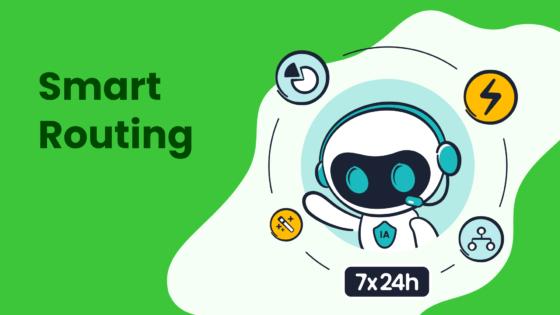
Service Level Agreement (SLA) Compliance
Service Level Agreement (SLA) compliance measures how well your call center meets predefined service standards. These agreements often include metrics like the average speed of answer or the percentage of calls answered within a specific time frame. Meeting SLA targets ensures your customers receive timely and efficient service, which directly impacts satisfaction and loyalty.
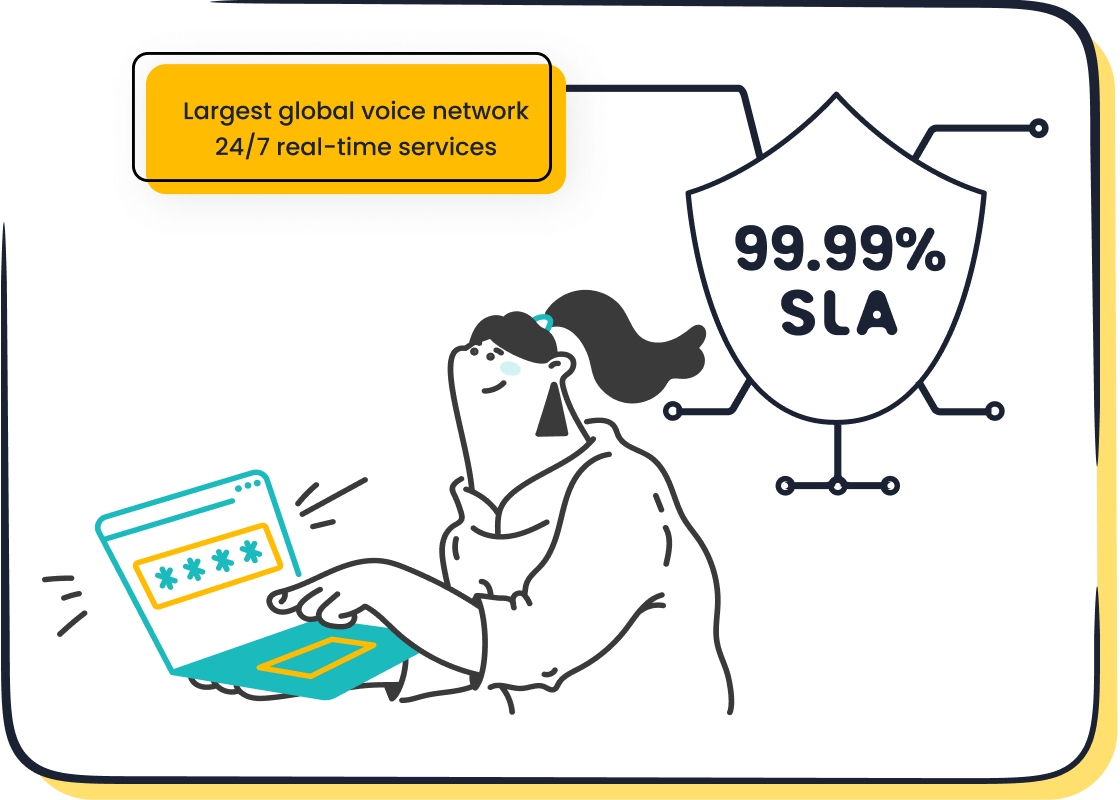
For example, a call center with an SLA requiring 90% of calls to be answered within 20 seconds must monitor performance closely. Falling short of this target can lead to customer frustration and missed opportunities. Tools like Sobot’s Voice/Call Center help you track SLA compliance in real time. Features such as smart call routing and AI-powered voicebots ensure calls are directed to the right agent quickly, reducing wait times and improving SLA adherence.
Cost Per Contact
Cost per contact is a critical metric for evaluating the financial efficiency of your call center. It calculates the total cost of handling a single customer interaction, including agent salaries, technology expenses, and overhead costs. Lowering this cost without compromising service quality can significantly boost your profitability.
You can reduce cost per contact by optimizing agent workflows and leveraging automation. For instance, Sobot’s unified workspace consolidates customer data, enabling agents to resolve issues faster. AI-powered tools like voicebots handle repetitive tasks, freeing agents to focus on complex inquiries. These efficiencies not only lower costs but also enhance customer satisfaction by reducing average handle time.
Call Volume Trends
Understanding call volume trends allows you to predict peak periods and allocate resources effectively. Analyzing past call data reveals patterns that help you forecast incoming call volumes. For example, retail call centers often experience spikes during holiday seasons, while financial services may see increased activity during tax filing periods.
Predictive analytics tools, like those offered by Sobot, provide insights into call arrival patterns. This information helps you adjust staffing levels proactively, ensuring agents are available when customers need them most. Proper resource allocation reduces wait times, improves agent performance, and prevents burnout. By staying ahead of call volume trends, you can maintain high service levels and meet customer expectations consistently.
Occupancy Rate
Occupancy rate measures the percentage of time agents actively handle customer interactions or related tasks compared to their total available time. This metric is crucial for balancing efficiency and agent well-being in your call center. Maintaining an optimal occupancy rate ensures your team remains productive without being overburdened.
- Typical Range: 75% to 85% occupancy is ideal for balancing efficiency and agent well-being.
- High Occupancy (Above 85%): Indicates agents may face fatigue, leading to lower service quality.
- Low Occupancy (Below 70%): Suggests inefficiencies like overstaffing or low interaction volume, resulting in wasted resources.
For example, a call center with an occupancy rate of 90% may experience higher agent turnover due to burnout. Conversely, a rate below 70% could signal underutilized resources, increasing operational costs. Striking the right balance ensures your agents remain engaged while delivering consistent service.
Sobot’s Voice/Call Center simplifies occupancy rate tracking with real-time analytics. Its unified workspace provides insights into agent activity, helping you optimize schedules and improve resource allocation. By leveraging these tools, you can maintain an ideal occupancy rate and enhance overall performance.
Forecast Accuracy
Forecast accuracy evaluates how well your call center predicts future contact volumes and resource needs. Accurate forecasting helps you allocate agents effectively, reducing wait times and improving the average speed of answer. This metric is essential for maintaining service levels during peak periods.
For instance, retail call centers often see spikes in contact volume during holiday seasons. Predicting these trends allows you to adjust staffing levels proactively, ensuring customers receive timely support. Studies show that call centers with high forecast accuracy reduce customer wait times by up to 30%, improving satisfaction and loyalty.
Sobot’s Voice/Call Center enhances forecasting with advanced analytics and AI-powered tools. By analyzing historical call data, you can identify patterns and predict future contact volumes. Features like smart call routing ensure agents are available when needed, minimizing delays and maintaining service quality. With Sobot’s solutions, you can achieve precise forecasting and deliver exceptional customer experiences.
Leveraging Sobot’s Voice/Call Center for KPI Optimization
Real-Time Monitoring and Analysis with Sobot
Real-time monitoring has revolutionized call center operations. It allows you to track key metrics like call resolution rates, average handle time, and customer satisfaction scores instantly. For example, high average handle times may signal the need for targeted coaching, while predictive analytics can help you prepare for peak contact periods. Supervisors can use real-time insights to mentor agents promptly, improving the quality of customer interactions and reducing call durations.
Sobot’s Voice/Call Center takes real-time monitoring to the next level. Its advanced analytics tools provide immediate visibility into ongoing calls and agent activities. This enables you to make quick adjustments to staffing and operations, ensuring efficiency and customer satisfaction. AI-driven monitoring also forecasts outcomes based on historical trends, helping you optimize staffing levels and prepare for high-volume periods. With Sobot, you can stay ahead of challenges and deliver exceptional service.
Enhancing First Contact Resolution with AI-Powered Voicebots
First contact resolution (FCR) is a critical metric for customer satisfaction. AI-powered voicebots have proven to enhance FCR rates significantly. For instance, Teneo’s AI-powered IVR system improved first-call resolution rates by 25%. Companies like Cdiscount also reported 30% fewer misrouted calls and a 25% better resolution rate using AI.
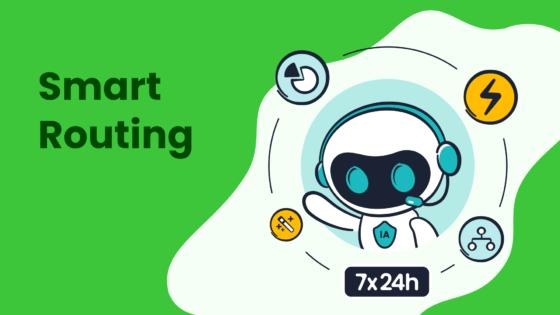
Sobot’s AI-powered voicebots streamline customer interactions by understanding intent and routing calls to the right agent or department. These voicebots handle repetitive queries efficiently, allowing agents to focus on complex issues. This not only improves FCR but also reduces customer frustration. By integrating Sobot’s intelligent voicebots, you can ensure faster resolutions and higher satisfaction rates.
Unified Workspace for Streamlined Agent Performance
A unified workspace simplifies workflows and boosts agent performance. It consolidates customer data, enabling agents to access all necessary information in one place. This reduces average handle time and improves first contact resolution. Metrics like customer satisfaction scores and call abandonment rates also benefit from a well-designed workspace.

Sobot’s unified workspace offers a comprehensive solution for managing customer interactions. Agents can view customer histories, track ongoing issues, and resolve queries efficiently. For example, performance evaluations based on metrics like AHT and FCR encourage skill development and improve service quality. By leveraging Sobot’s unified workspace, you can enhance agent productivity and deliver seamless customer experiences.
Data-Driven Insights for Operational Efficiency
Data-driven insights are essential for improving operational efficiency in your call center. By analyzing real-time data, you can identify trends, optimize workflows, and enhance overall performance. For example, AI call analytics can process conversations at scale, uncovering actionable insights that help you make informed decisions. These insights allow you to address inefficiencies and improve service delivery.
Performance evaluation is another key benefit of data-driven tools. You can monitor call duration, customer satisfaction, and agent compliance with protocols. This helps you identify areas where your team excels and where improvements are needed. Additionally, analyzing customer inquiries can reveal training gaps, enabling you to provide targeted coaching for your agents. This approach not only boosts agent performance but also enhances the customer experience.
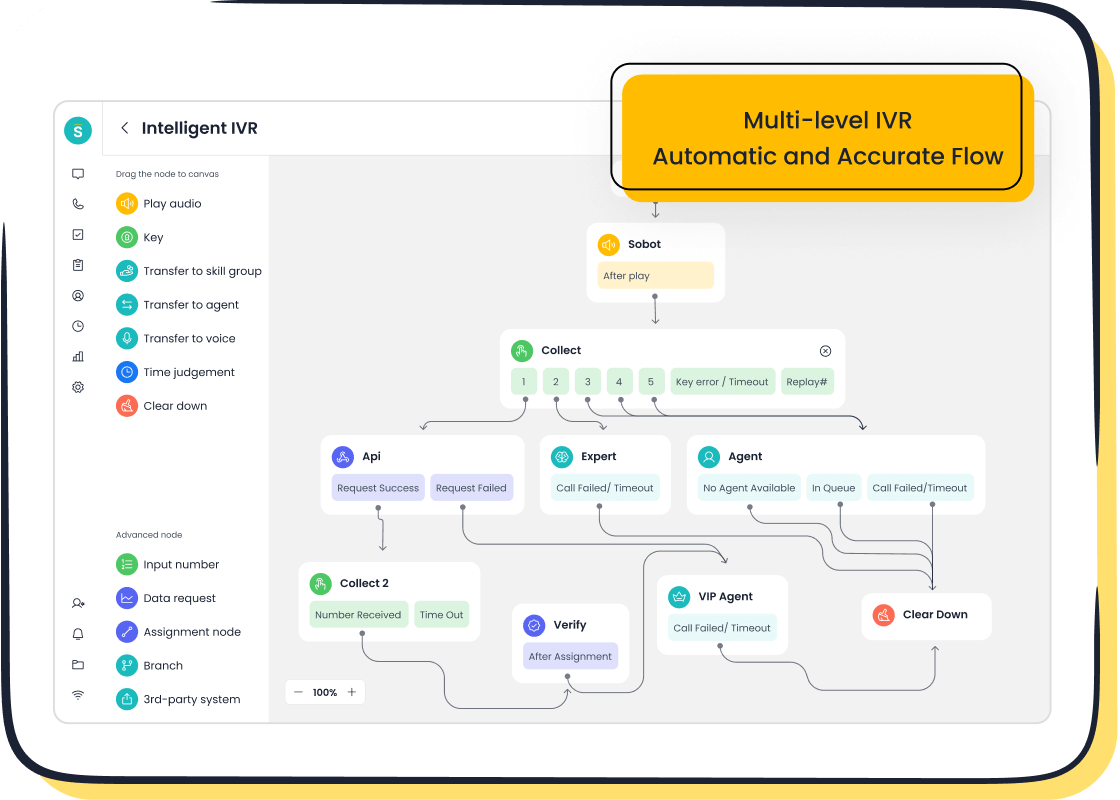
A culture of continuous improvement thrives on data. Regularly reviewing analytics fosters a proactive mindset, encouraging your team to strive for better results. Sobot’s Voice/Call Center supports this by offering advanced analytics tools that provide real-time insights. These tools help you track key metrics like average handle time and first contact resolution, ensuring your operations remain efficient and customer-focused.
| Evidence Type | Description |
|---|---|
| AI Call Analytics | Transforms call center operations by analyzing conversations at scale for actionable insights. |
| Performance Evaluation | Enables evaluation of call duration, customer satisfaction, and agent compliance with protocols. |
| Training Gap Identification | Identifies areas where agent training can be improved based on customer inquiries and needs. |
| Continuous Improvement Culture | Fosters a culture of ongoing enhancement in service delivery and operational efficiency. |
Integration Capabilities for Seamless KPI Tracking
Seamless integration is crucial for effective KPI tracking in your call center. When your systems work together, you gain a unified view of customer interactions and agent performance. This simplifies the process of monitoring metrics and ensures you can make data-driven decisions quickly.
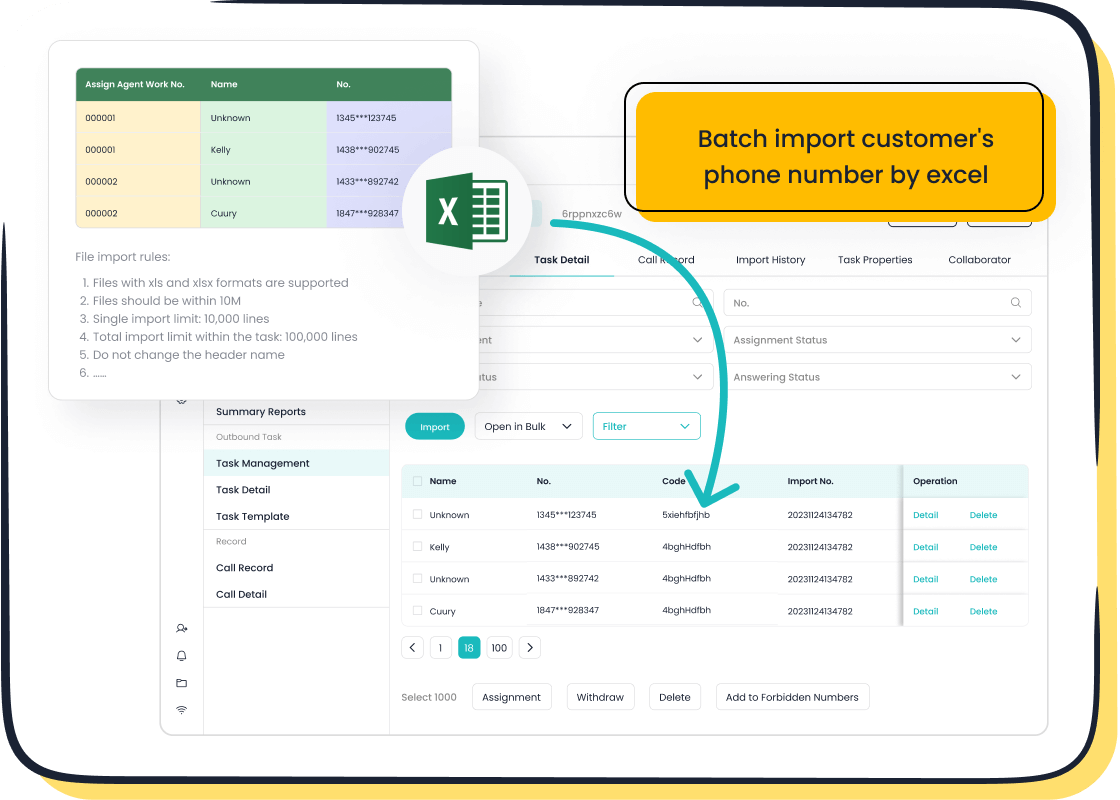
Sobot’s Voice/Call Center excels in integration capabilities. It connects effortlessly with CRM systems, ticketing platforms, and other tools you already use. This allows you to consolidate data from multiple sources into a single platform. For example, integrating customer histories with call data enables agents to provide personalized service, improving first contact resolution rates.
Integration also reduces manual tasks, freeing your agents to focus on meaningful interactions. By automating workflows, you can ensure consistent service delivery and reduce errors. With Sobot’s solutions, you can track KPIs like customer satisfaction and average handle time in real time, helping you stay ahead of challenges and deliver exceptional service.
Tracking the right key performance indicators is essential for call center success in 2025. Metrics like Customer Satisfaction Score (CSAT), First Call Resolution (FCR), and Average Handle Time (AHT) provide actionable insights into customer happiness, operational efficiency, and service quality. For example, unresolved client issues still account for 20% to 30% of communication volume, highlighting areas for improvement. By focusing on these metrics, you can enhance customer experiences, optimize agent performance, and streamline operations.
Sobot’s Voice/Call Center empowers you to achieve these goals with tools like AI-powered voicebots, real-time analytics, and a unified workspace. These features simplify KPI tracking, enabling data-driven decisions that improve outcomes. As voice and text analytics usage grows—rising from 62% in 2020 to 81% in 2022—embracing advanced technologies like Sobot’s solutions ensures your call center stays competitive and customer-focused.
FAQ
What are the most important call center KPIs to track in 2025?
The most critical KPIs include Customer Satisfaction Score (CSAT), First Contact Resolution (FCR), Average Handle Time (AHT), and Net Promoter Score (NPS). These metrics help you measure customer satisfaction, agent performance, and operational efficiency. Tools like Sobot’s Voice/Call Center simplify tracking these KPIs with real-time analytics.
How can AI improve call center KPI performance?
AI enhances KPI performance by automating repetitive tasks, improving first-contact resolution, and reducing average handle time. For example, Sobot’s AI-powered voicebots streamline customer interactions by understanding intent and routing calls efficiently. This leads to faster resolutions and higher customer satisfaction.
Why is First Contact Resolution (FCR) so important?
FCR directly impacts customer satisfaction and operational efficiency. Resolving issues on the first call reduces frustration and builds loyalty. Studies show that improving FCR by just 1% can increase customer satisfaction by 1%. Sobot’s smart call routing ensures calls reach the right agent, boosting FCR rates.
How does Sobot help reduce agent turnover?
Sobot’s unified workspace simplifies workflows, reducing stress and improving job satisfaction. Features like smart call routing and AI-powered tools minimize repetitive tasks, allowing agents to focus on meaningful interactions. This approach helps you retain skilled agents and maintain a stable team.
Can Sobot integrate with existing systems for seamless KPI tracking?
Yes, Sobot’s Voice/Call Center integrates effortlessly with CRM systems, ticketing platforms, and other tools. This seamless integration consolidates data, enabling you to track KPIs like CSAT and AHT in real time. It ensures consistent service delivery and data-driven decision-making.
See Also
Best 10 Call Center Analytics Tools For 2024
Effective Strategies For Quality Management In Call Centers
Leading Cloud Contact Center Solutions To Consider In 2024
